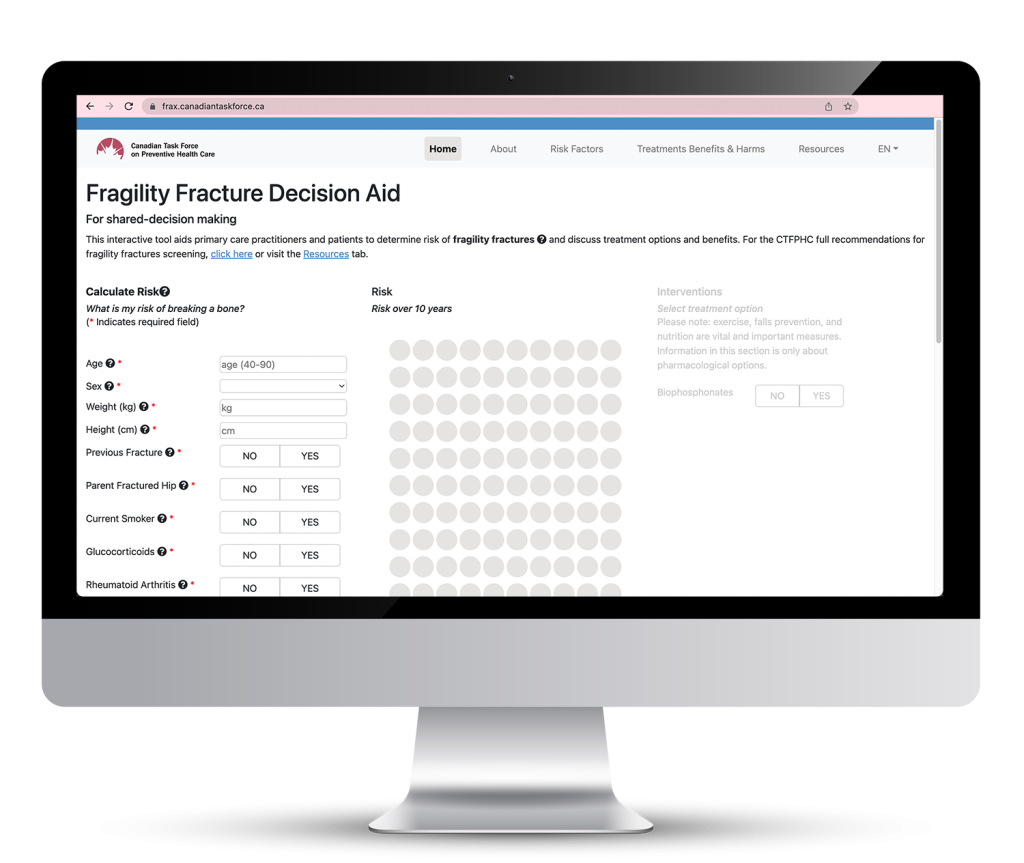New guideline and decision aid
Should you screen to help reduce the risk of fragility fractures? A new interactive online Fragility Fracture Decision Aid for shared decision-making can help clinicians and patients visualize their individual risk of fracture and the potential benefits and harms of preventive treatment.
The decision aid is part of a new guideline from the Canadian Task Force on Preventive Health Care on screening to prevent fragility fractures. The guideline recommends:
- A “risk assessment-first” screening process for women 65 years and older, centred around shared-decision making with their primary care providers
- Women should be informed of their risk and supported in their decisions on further testing and preventive treatment
- Screening is not recommended for females under 65 or males of any age


“Fragility fractures can severely affect quality of life for older adults,” said Dr. Guylene Theriault, chair of the task force fragility fractures working group. “For women over age 65, there is good evidence that screening and preventive treatment may reduce fragility fractures. Surprisingly, screening occurs in younger women and men, although there is no evidence of benefit.”
Putting into Practice
Clinicians should use a risk assessment-first screening strategy for females ≥65 years:
- Use the Fragility Fractures Decision Aid. This aid uses the Canadian FRAX risk assessment tool to estimate an individual’s risk
- Help patients consider their risk of fragility fracture and the potential benefits and harms of treatment
- Engage in shared decision-making to help patients decide if they would take prescription medication based on their personal risk level
If the patient is considering prescription medication:
- Request a BMD test
- Re-estimate fracture risk by adding the T-score into FRAX to decide on treatment

Benefits
- Saves time for clinician and patient
- Reduces risk of overdiagnosis and overtreatment
- Promotes shared decision-making

“We hope a risk assessment-first approach will help reduce unnecessary BMD tests both for patients and the health care system. It doesn’t make sense to order tests that will not lead to treatment decisions.”
– Dr. Donna Reynolds, a family physician and task force member
Who is the target population?
- Community dwelling adults aged 40+
- It does not apply to people already taking prescription medication to prevent fragility fractures
What are fragility fractures?
- Fragility fractures are breaks at the hip, spine, wrist and other areas after a fall that would not normally occur if bones were sufficiently strong.
- They are due to underlying weakened bone structure, also referred to as low bone mineral density. Fractures can lead to chronic pain, disability, hospitalization, need for long-term institutional care and earlier death.
What should the public know?
- Females aged 65 years and older may be able to avoid fracture with screening and preventive medication
- Screening is not recommended for females under 65 or males of any age
- Patients can use the online Fragility Fracture Decision Aid to calculate their individual risk level; if fracture risk is low, benefit of treatment is low
- The decision aid can help the patient-clinician conversation as it calculates the potential impact of medication and potential harms
- Recommendations are based on a detailed review of the latest evidence that found
- benefit of screening in females aged 65+
- no benefit of screening men of any age or women ≤65
“This new information will surely help family physicians and patients have meaningful discussions and forego unnecessary tests. Why do a test if your risk is low and you’re not interested in taking preventive medication?”
– Marie-France, a patient in her 50s living in Quebec who has had many BMD tests
Recommendations on screening for primary prevention of fragility fractures was published in CMAJ on May 8, 2023.
Endorsement
The College of Family Physicians of Canada has endorsed the guideline.



